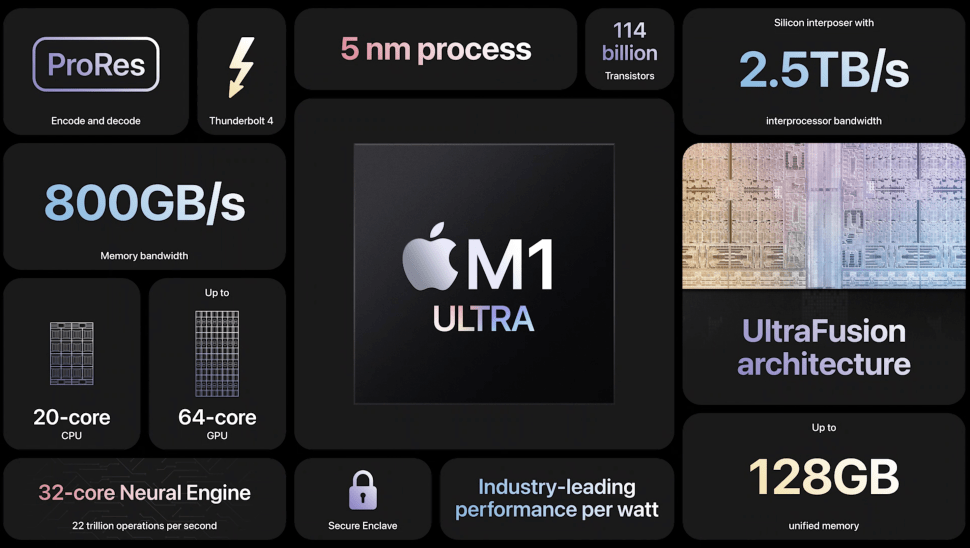The M1 Ultra is the latest silicon from Apple, and the most powerful M1 chip ever manufactured by the company. Launched in March 2022, the M1 Ultra is Apple’s new flagship SoC (system-on-chip) that is going to power the all-new Mac Studio.
At its core, the M1 Ultra comprises two M1 Max chips paired together with a very peculiar feature of the chip. A die-to-die interconnection, that facilitates two M1 Max chips to work together, bringing forth new standards in computing.
Apple is calling this new interconnection technology, ‘UltraFusion’ that is going to unleash unprecedented performance. In this article, we are going to discuss everything there is to know about M1 Ultra. Furthermore, how this new chip is going to disrupt the market for good.

Also Read: Apple’s RealityOS: A New OS to Power AR/VR headsets
Apple M1 Ultra: Specifications
- 20 cores CPU and 64 cores GPU
- 7x more transistors than M1, 114 billion
- Up to 128 GB unified memory (RAM)
- 32 cores Neural Engine
- Capable of delivering faster graphics performance than higher-end discrete GPU, while using 200W less power
- Can handle 14 ProRes streams simultaneously
Everything Apple M1 Ultra has to Offer
Just like every other Apple silicon, the M1 Ultra integrates both the CPU and GPU units together. Drawing from the same unified RAM pool, it results in a higher efficiency while minimizing latency to a certain degree.
The M1 Ultra has a similar architecture, where two M1 Max chips are physically connected using the so-called ‘hidden feature’ of the M1 Max. This allows Apple’s silicon interposer to achieve up to 2.5TB/s of interprocessor bandwidth.

According to Apple, the silicon interposer for UltraFusion has twice the connection density along with four times the bandwidth as competing interposers. Given, this is AMD’s and Nvidia’s area of expertise from their HBM (High Bandwidth Memory) on enterprise GPUs.
UltraFusion is also advantageous for developers, as it won’t require them to rewrite codes. On a system level, the Mac detects the two SoCs as a single chip. Furthermore, the M1 Ultra is built on TSMC’s 5nm architecture, capable of executing 22 trillion operations per second.
According to a report published on Digitimes, Apple’s M1 Ultra SoCs is using TSMC’s CoWoS-S. It is an abbreviation for chip-on-wafer-on substrate with silicon interposer. Basically, a packaging process is used on a 2.5D interposer.

Although Taiwanese Chipmaker TSMC has already proposed a newer alternative to CoWoS-S. The InFO_LSI (InFO with the integration of LSI), is capable of higher bandwidth chiplet integration. Although Apple ended up going with CoWoS-S instead of InFO_LSI due to its unavailability during the launch of M1 Ultra.
Also Read: Apple Announced iPhone SE, Mac Studio, iPad and Studio Display in ‘Peek Performance’ Event
The Bottom Line
This goes without saying, Apple has caught everyone by surprise. While anticipating an all-new M2 chip, Apple dropped the top-tier M1 Ultra. Given the computational capabilities of M1 Max from last year, there is nothing worth complaining about as well. So, let us know in the comment section below, are you excited about trying out the all-new M1 Ultra?












